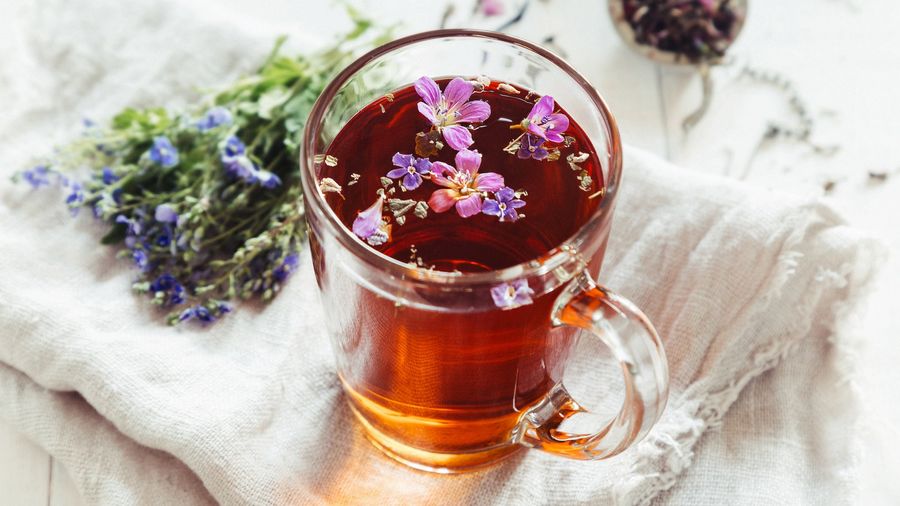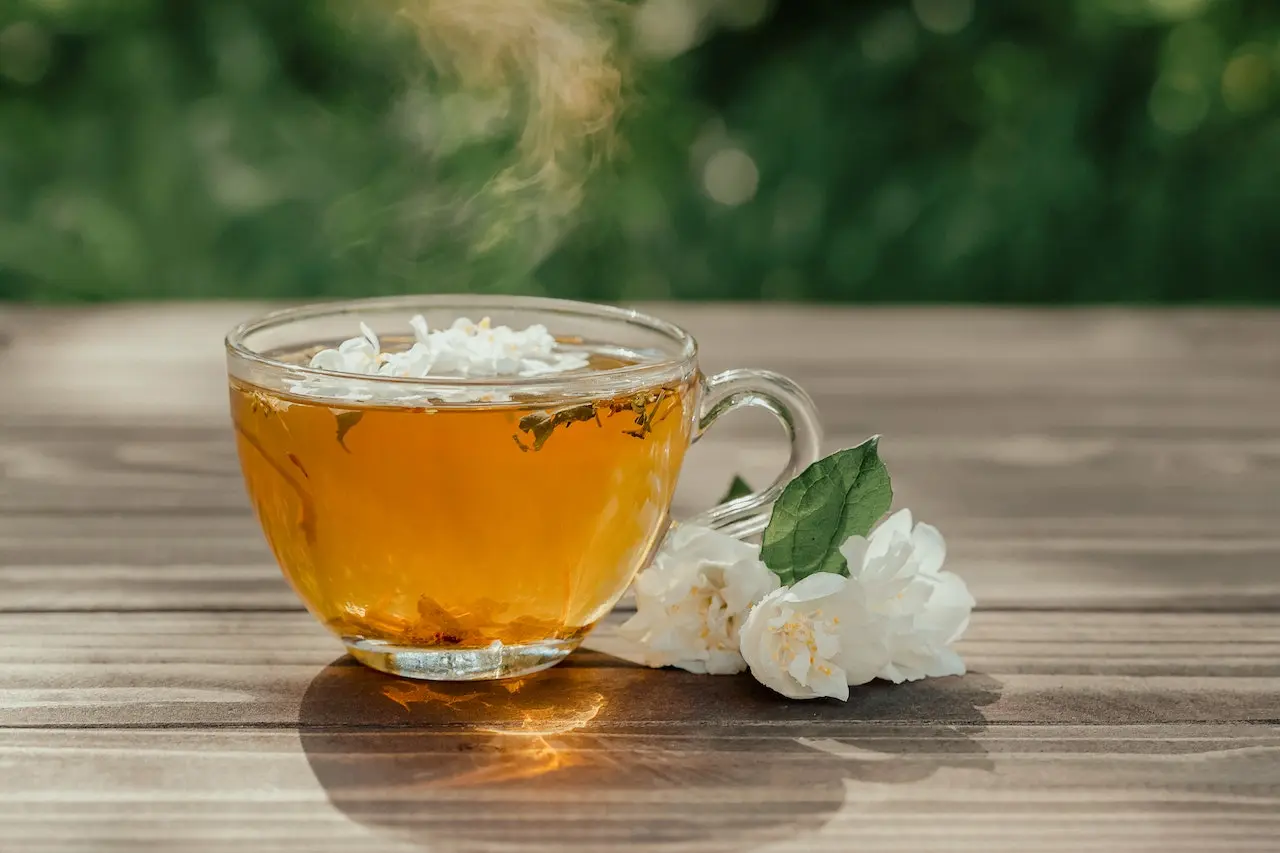· teas · 9 min read
All About Flower Teas
Flower teas are a type of tea that is made from dried flowers and herbs. These teas are not only delicious but also visually stunning, with the flowers and herbs adding a beautiful and colorful touch to your cup.

Flower teas are made by infusing dried flowers in hot water to extract their flavors, aromas, and potential health benefits.
Process of Making Flower Tea
Harvesting
The flowers used for tea are typically harvested at their peak bloom. This ensures that they possess the best flavors and qualities for brewing.
Drying
After harvesting, the flowers are carefully dried to preserve their flavors and prevent spoilage. Drying methods can vary, including air-drying, sun-drying, or using specialized drying equipment.
Sorting and Cleaning
Once dried, the flowers are sorted to remove any impurities or unwanted parts. This step ensures that only the best-quality flowers are used for tea production.
Grinding (Optional)
In some cases, flowers are ground into a fine powder to create a more concentrated flavor. This is common for certain flower teas, such as rose or chamomile.
Blending (Optional)
Flowers may be blended with other flowers or ingredients to create unique flavor profiles. This allows tea producers to experiment and create interesting combinations of aromas and tastes.
Packaging of Flower Tea
The dried flowers or floral blends are carefully packaged to maintain their freshness and quality. Packaging materials may include sealed bags, tins, or containers that protect the flowers from light, moisture, and air.
It’s important to note that different types of flowers may require slight variations in the process. For example, certain flowers like jasmine are often used to scent green tea leaves, while others like hibiscus are used solely for their petals. The specific techniques and methods used to make flower teas may also vary among tea producers, contributing to the uniqueness of each brand and blend.
Popular Types of Flower Tea
Chamomile Tea
Chamomile flowers are known for their calming and soothing properties. Chamomile tea has a mild, floral taste and is often enjoyed before bedtime to promote relaxation and aid in sleep.
Rose Tea
Rose petals create a fragrant and subtly sweet infusion. Rose tea is often used for its potential mood-lifting and stress-relieving effects. It can be enjoyed on its own or blended with other flowers or teas for a delightful floral flavor.
Jasmine Tea
Jasmine tea is made by scenting green tea leaves with jasmine flowers. This process creates a beautifully aromatic tea with a delicate and floral taste. Jasmine tea is often consumed for its calming properties and is a popular choice in Chinese tea culture.
Hibiscus Tea
Hibiscus flowers create a vibrant and tangy infusion. Hibiscus tea has a bright red color and a refreshing, slightly tart flavor. It is known for its potential to support cardiovascular health and is rich in antioxidants.
Lavender Tea
Lavender flowers impart a distinctive floral and herbal flavor to tea. Lavender tea is often enjoyed for its soothing and calming effects, promoting relaxation and stress reduction.
Peony Tea
Peony flowers can be used to create a delicate and subtly sweet tea. Peony tea is known for its potential antioxidant properties and is valued for its floral aroma.
History of Flower Tea
Flower teas have an ancient multi-cultural history which spans the globe.
China
In China, the use of flowers in tea can be traced back to ancient times. The Chinese were among the first to recognize the medicinal and aromatic properties of flowers. They began infusing dried flowers into hot water to create herbal infusions, or flower teas, as a way to promote health and well-being.
One of the most renowned flower teas in China is jasmine tea. The process of scenting green tea leaves with jasmine flowers originated in the Song Dynasty (960-1279). Jasmine flowers were layered with tea leaves, allowing the leaves to absorb the fragrance over several nights. This delicate and fragrant tea gained popularity and became a staple in Chinese tea culture.
Additionally, chrysanthemum tea holds a significant place in Chinese tradition. It has been consumed for centuries and is believed to have cooling properties. Chrysanthemum flowers are steeped in hot water to create a light and refreshing infusion.
Middle East and Ancient Egypt
Flower teas were also consumed in the Middle East and Ancient Egypt. In ancient Egypt, hibiscus flowers were brewed into a tea known as “Karkade.” This vibrant red tea was not only enjoyed for its flavor but also for its believed health benefits, including its cooling effect in hot climates.
India
In India, Ayurvedic traditions incorporated flowers into medicinal herbal teas. Flowers such as rose, chamomile, and hibiscus were used to create soothing and healing infusions.
Europe
In Europe, flower teas gained popularity during the Renaissance era. Herbal infusions containing flowers such as chamomile, lavender, and rose were consumed for their relaxing and therapeutic effects. These teas were often enjoyed for their calming properties and were believed to aid in digestion, promote sleep, and alleviate various ailments.
Modern Flower Tea Culture: Going Global
Today, flower teas have become a global phenomenon, enjoyed for their delicate flavors, aromas, and potential health benefits. They are valued not only for their taste but also for their visual appeal, with many flower teas unfurling and blooming as they steep in hot water. Whether for their therapeutic properties or as a sensory experience, flower teas continue to captivate tea lovers around the world. Their rich history, cultural significance, and diverse range of flavors make them a delightful and rejuvenating choice for tea enthusiasts.
Health Benefits of Flower Tea
Flower teas have many health benefits, such as:
Relaxation and Stress Relief
Many flower teas, such as chamomile and lavender, are known for their calming properties. They can help reduce stress, promote relaxation, and improve sleep quality.
Digestive Aid
Some flower teas, like peppermint and ginger, have been used to alleviate digestive issues such as bloating, nausea, and indigestion.
Antioxidant Boost
Flower teas, such as hibiscus and rose, are rich in antioxidants that help protect the body against free radicals, support immune function, and reduce the risk of chronic diseases.
Respiratory Support
Certain flower teas, including elderflower and chamomile, may help relieve respiratory ailments such as coughs, colds, and congestion.
Anti-inflammatory Effects
Flowers like calendula and chamomile have anti-inflammatory properties that can help reduce inflammation in the body and provide relief for conditions such as arthritis or skin irritations.
Hydration and Detoxification
Flower teas, when consumed without added sweeteners, can contribute to daily hydration and support the body’s natural detoxification processes.
How to Make Flower Tea
Making flower teas is a delightful and simple process.
Gather your ingredients
Dried flowers of your choice (such as chamomile, rose, hibiscus, lavender, etc.)
Hot water
Boil water
Bring fresh water to a boil. The exact temperature will depend on the specific flower you are using. As a general rule, avoid using boiling water for delicate flowers like chamomile and lavender, as it may affect their flavors. Opt for water temperatures around 200°F (93°C) for most flowers.
Prepare the flowers
Measure the desired amount of dried flowers. A general guideline is 1-2 teaspoons of dried flowers per cup of water, but you can adjust according to your taste preferences.
If using loose flowers, place them in a tea infuser or a teapot. Alternatively, you can place them directly in a cup or mug.
Pour the hot water
Slowly pour the hot water over the flowers, ensuring that they are fully submerged.
Steep the flowers
Let the flowers steep in hot water for 5-10 minutes. Adjust the steeping time based on the desired strength of flavor. Some flowers, like chamomile and lavender, may require longer steeping times for optimal flavor extraction.
Strain and serve
If using loose flowers, remove the infuser or strain the tea to separate the liquid from the flowers. If using teabags, simply remove the teabag from the cup.
If desired, add sweeteners like honey or sugar to taste. You can also enhance the flavor by adding lemon slices or other herbs.
Enjoy your flower tea
Sip and savor your aromatic and flavorful flower tea. Feel free to experiment with different flower combinations and explore your preferences.
Remember, the brewing time and water temperature may vary depending on the type of flowers you are using. It’s always a good idea to consult the specific instructions provided with the flowers or experiment to find the perfect steeping parameters for your taste.

Popular Brands of Flower Tea
Harney & Sons
Harney & Sons is a renowned tea company that offers a wide range of teas, including floral blends. Their flower tea collection includes flavors like chamomile, rose petals, and lavender, which are known for their soothing and aromatic qualities.
Teavana
Teavana offers a variety of flower teas and herbal infusions. Their selection includes blends like Jasmine Dragon Phoenix Pearls, which combines green tea and jasmine flowers, as well as chamomile and mint infusions.
Numi Organic Tea
Numi Organic Tea is committed to using organic and sustainably sourced ingredients. They offer flower teas like chamomile, hibiscus, and rooibos blends, providing a variety of floral flavors for tea lovers to enjoy.
Yogi Tea
Yogi Tea is known for its herbal blends, including flower teas. Their selection includes soothing and aromatic options like Calming, Bedtime, and Honey Lavender Stress Relief, which incorporate flowers for their calming properties.
Fun Facts about Flower Tea
Aromatherapy in a Cup
Flower teas often carry fragrant aromas that can uplift the senses and promote relaxation. The aroma of flowers like lavender, jasmine, or rose can have a calming effect on the mind and body.
Herbal Infusions
Many flower teas are technically herbal infusions or tisanes, as they don’t contain leaves from the Camellia sinensis plant, which is used to make traditional teas like black or green tea. This makes flower teas a caffeine-free alternative.
Culinary Uses
Flower teas can also be used in cooking and baking to infuse flavors into dishes. Flowers like rose, lavender, and hibiscus are popular choices for adding floral notes to desserts, beverages, and even savory recipes.
Spa-like Experience
Flower teas are often associated with wellness and spa treatments. They are frequently used in herbal baths, facial steams, and skincare products due to their potential soothing and rejuvenating properties.
Sustainable and Eco-friendly
Flower teas are typically made from natural, plant-based ingredients and are often sourced sustainably. Choosing flower teas can support environmentally conscious practices in tea production.
Whether you’re looking for a relaxing drink to help you unwind or a flavorful beverage to brighten up your day, flower teas are a great choice.